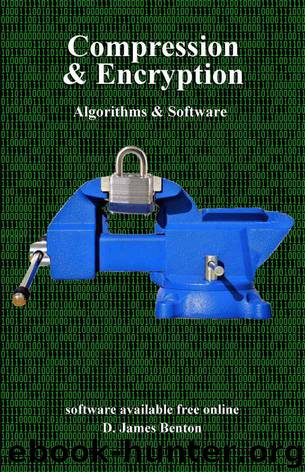Compression & Encryption: Algorithms & Software by D. James Benton

Author:D. James Benton [Benton, D. James]
Language: eng
Format: epub
Publisher: UNKNOWN
Published: 2019-07-14T22:00:00+00:00
Chapter 14. MP3
The MP3 audio compression and associated file format was developed by Moving Picture Experts Group (MPEG) and initially release in 1993. It was originally designated MPEG-1 (or MPEG–2) Audio Layer III and later shortened. MP3 uses lossy data-compression through approximation as well as discarding parts of the data, which are considered less important or cannot be detected by the human ear. Sound data are subjected to what is called psychoacoustic analysis—an elaborate term referring to the hearing capability and perception of most humans. Typical compression ratios are 75% to 95%, much like that achieved with JPG encoding of photographs.
Sound data on a CD has the form of literal digitized intensities at some specified sampling rate (e.g., 8, 12, 16, 24, 32, or 48 kHz). There may be a single (mono) or two (stereo) data streams. MP3 roughly follows this same categorization, only compressed by transforming the data from the temporal (time) to tonal (frequency) domain. Playback involves the reverse transformation into the time domain While MP3 was only supported by a few software and hardware products in the 1990s, it is now ubiquitous. The Web abounds with free MP3 software, music is readily available, and so are players. Virtually all cellular phones and smart devices recognize the format. A Fast Fourier Transform (FFT) is used to convert the sound data from the time to frequency domain, followed by integer approximation and truncation, as well as filtering. Specific details of the file format and the transformation process will be left to the many web sites devoted to this subject.
Download
This site does not store any files on its server. We only index and link to content provided by other sites. Please contact the content providers to delete copyright contents if any and email us, we'll remove relevant links or contents immediately.
Algorithms of the Intelligent Web by Haralambos Marmanis;Dmitry Babenko(8532)
Test-Driven Development with Java by Alan Mellor(7448)
Data Augmentation with Python by Duc Haba(7335)
Principles of Data Fabric by Sonia Mezzetta(7084)
Learn Blender Simulations the Right Way by Stephen Pearson(7028)
Microservices with Spring Boot 3 and Spring Cloud by Magnus Larsson(6843)
RPA Solution Architect's Handbook by Sachin Sahgal(6257)
Hadoop in Practice by Alex Holmes(6039)
The Infinite Retina by Robert Scoble Irena Cronin(5961)
Jquery UI in Action : Master the concepts Of Jquery UI: A Step By Step Approach by ANMOL GOYAL(5878)
Big Data Analysis with Python by Ivan Marin(5749)
Life 3.0: Being Human in the Age of Artificial Intelligence by Tegmark Max(5410)
Pretrain Vision and Large Language Models in Python by Emily Webber(4708)
Infrastructure as Code for Beginners by Russ McKendrick(4489)
WordPress Plugin Development Cookbook by Yannick Lefebvre(4215)
Functional Programming in JavaScript by Mantyla Dan(4129)
The Age of Surveillance Capitalism by Shoshana Zuboff(4127)
Embracing Microservices Design by Ovais Mehboob Ahmed Khan Nabil Siddiqui and Timothy Oleson(4009)
Applied Machine Learning for Healthcare and Life Sciences Using AWS by Ujjwal Ratan(3985)
